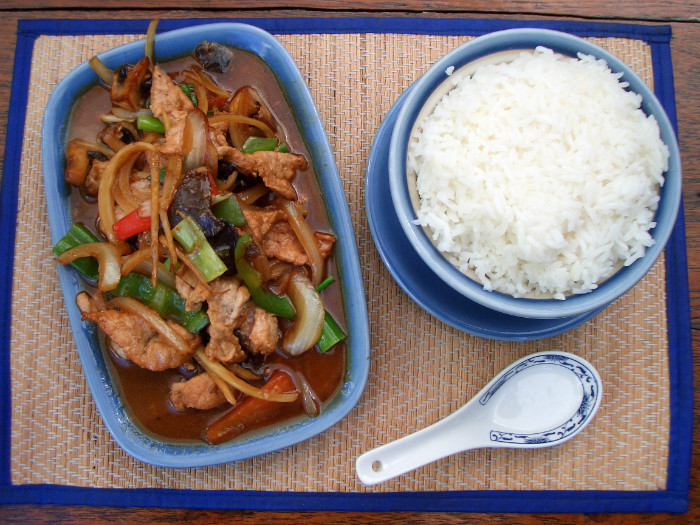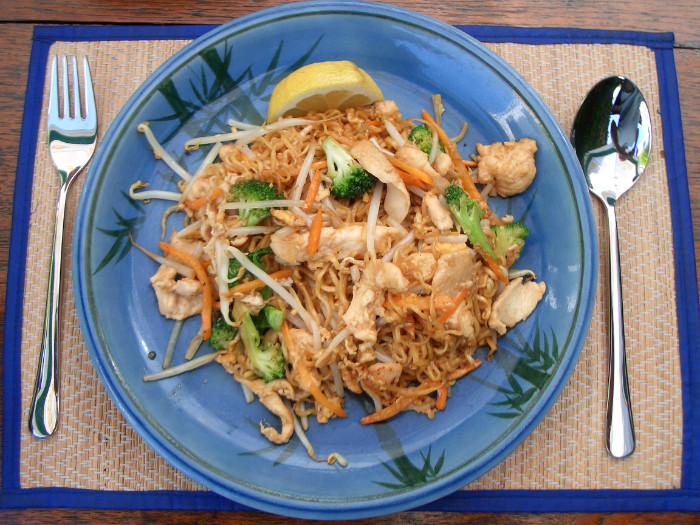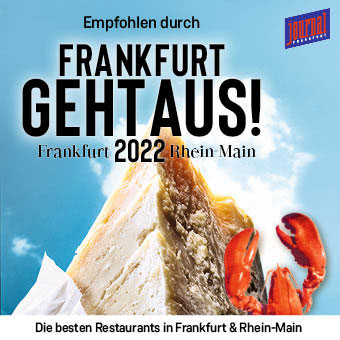Information about the Thai cuisine
 The Thai cuisine is internationally known. Whether chilli-hot or similarly mild, the harmony in the composition is the leitmotif of every dish. Thai cuisine is essentially a combination of centuries-old Eastern and Western influences that have been harmoniously fused into something typically Thai. Different accents are set depending on who cooks the Thai food, for whom it is cooked, for which occasion and where it is cooked. The dishes can be refined and adapted to the respective palate. Originally, Thai cuisine reflected a way of life that is closely related to water. The main ingredients of the dishes were aquatic animals, aquatic plants and herbs. Originally, large cuts of meat were avoided in Thai cuisine. However, subsequent influences introduced this use into Thai cuisine. Because of their Buddhist background, the Thai people chopped up the pieces of meat and mixed them with herbs and spices. Traditional cooking methods in Thai cuisine were stewing and baking or grilling. The methods of frying, stir-frying and deep-frying were introduced through Chinese influences. Portuguese, Dutch, French and Japanese culinary influences have played a role in Thai cuisine since the 17th century. Chiles were introduced to Thai cuisine in the late 17th century by Portuguese missionaries who had learned to appreciate the spice while serving in South America.
The Thai cuisine is internationally known. Whether chilli-hot or similarly mild, the harmony in the composition is the leitmotif of every dish. Thai cuisine is essentially a combination of centuries-old Eastern and Western influences that have been harmoniously fused into something typically Thai. Different accents are set depending on who cooks the Thai food, for whom it is cooked, for which occasion and where it is cooked. The dishes can be refined and adapted to the respective palate. Originally, Thai cuisine reflected a way of life that is closely related to water. The main ingredients of the dishes were aquatic animals, aquatic plants and herbs. Originally, large cuts of meat were avoided in Thai cuisine. However, subsequent influences introduced this use into Thai cuisine. Because of their Buddhist background, the Thai people chopped up the pieces of meat and mixed them with herbs and spices. Traditional cooking methods in Thai cuisine were stewing and baking or grilling. The methods of frying, stir-frying and deep-frying were introduced through Chinese influences. Portuguese, Dutch, French and Japanese culinary influences have played a role in Thai cuisine since the 17th century. Chiles were introduced to Thai cuisine in the late 17th century by Portuguese missionaries who had learned to appreciate the spice while serving in South America.
 Thais adapted foreign methods to their own circumstances and replaced some ingredients. For example, pure butterfat used in Indian cooking has been replaced with coconut oil, and coconut milk has replaced other dairy products. Excessively strong pure spices were softened and refined with fresh herbs such as lemongrass and galangal (type of ginger). Gradually fewer spices were used in the preparation of Thai curries, while more fresh herbs were used. It is widely known that Thai curries are very hot, but the burning sensation in the mouth disappears quickly, whereas curries from other countries with intense spices keep the burning sensation in the mouth longer. Instead of serving the dishes one after the other, all the dishes in a meal are served at once, so that the diner can try different combinations of dishes and different flavors. A full Thai menu should consist of a soup, a curry dish with spices and a dip with accompanying fish and vegetables. A spicy salad can replace the curry dish. The soup can also be spicy, but the curry should then be replaced by a mild dish. What is important is the harmony of taste, the composition of the individual dishes and the entire meal.
Thais adapted foreign methods to their own circumstances and replaced some ingredients. For example, pure butterfat used in Indian cooking has been replaced with coconut oil, and coconut milk has replaced other dairy products. Excessively strong pure spices were softened and refined with fresh herbs such as lemongrass and galangal (type of ginger). Gradually fewer spices were used in the preparation of Thai curries, while more fresh herbs were used. It is widely known that Thai curries are very hot, but the burning sensation in the mouth disappears quickly, whereas curries from other countries with intense spices keep the burning sensation in the mouth longer. Instead of serving the dishes one after the other, all the dishes in a meal are served at once, so that the diner can try different combinations of dishes and different flavors. A full Thai menu should consist of a soup, a curry dish with spices and a dip with accompanying fish and vegetables. A spicy salad can replace the curry dish. The soup can also be spicy, but the curry should then be replaced by a mild dish. What is important is the harmony of taste, the composition of the individual dishes and the entire meal.
How do you order and eat Thai
You eat Thai with a fork and a spoon. Even meals that only consist of one dish, e.g. fried rice with pork or steamed rice with fried duck, are served in bite-sized strips or pieces of meat, so that no knife is required. The spoon carries the food to the mouth.
 Ideally, Thai food is a social affair that involves two or more people. Basically because of the larger number of dishes that can be ordered when there are several diners at the table. Usually two people order three dishes in addition to their own plates of steamed rice, three people order four dishes, and so on. The people choose what they want to try from the dishes they order together and put it on their plate with the rice. Soups are eaten with the other dishes, not independently of them. Spicy dishes are balanced out by mild dishes.
Ideally, Thai food is a social affair that involves two or more people. Basically because of the larger number of dishes that can be ordered when there are several diners at the table. Usually two people order three dishes in addition to their own plates of steamed rice, three people order four dishes, and so on. The people choose what they want to try from the dishes they order together and put it on their plate with the rice. Soups are eaten with the other dishes, not independently of them. Spicy dishes are balanced out by mild dishes.
The ideal Thai meal is a harmonious mixture of spicy, mild and sweet and sour and should satisfy the eyes and nose as well as the palate. A typical meal could consist of a clear soup, a boiled or fried dish (perhaps bitter melons filled with pork that is seasoned with peppermint), a fried dish (fish with ginger), a spicy salad (strips of beef on lettuce, onions, Chiles, peppermint and lemon juice) and a selection of sauces in which certain ingredients are dipped. This would be followed by a sweet dessert and / or fresh fruit such as mangoes, durian, jackfruit, papayas, grapes or melons.
What is a Thai menu made of
TITBITS
They can serve as hors d'oeuvres, side dishes or snacks. Titbits include spring rolls, satay or puffed rice slices with herb toppings. They represent the playful and creative nature of the Thai people.
SALADS
The essential thing is the harmony between the flavors. Depending on the nature of the meat and the occasion, the spices may vary.
ADDITIONAL DISHES
A sweet and sour dish, a fluffy omelette or a stir-fry dish often help complete the meal.
DIPS
Dips can be used in many ways. For example, they can be the main meal if they are served with vegetables and different types of meat. Thinly prepared dips can be used as a salad dressing. A very popular and easy to prepare dip is made from chiles, garlic, dried shrimp, lime juice, fish sauce, sugar and shrimp paste.
SOUPS
A good meal that will satisfy the average eater can be simple soup and rice. Traditional Thai soups are unique in that they have more flavors and textures than other foods.
CURRIES
Most non-Thai curries use powdered or ground dried spices, whereas the main ingredients in Thai curries are fresh herbs. A simple Thai curry paste consists of dried chiles, shallots, and a shrimp paste. More elaborate curries also include garlic, galangal (type of ginger), coriander roots, lemongrass, kaffir lime peel and peppercorns.
Meals that consist of only one dish and constitute a complete meal are rice or noodle dishes such as Khao Phat and Phat Thai.
DESSERTS
A Thai dessert goes with every good meal. All desserts are very sweet and therefore particularly welcome after heavily seasoned meals or meals prepared with herbs.





